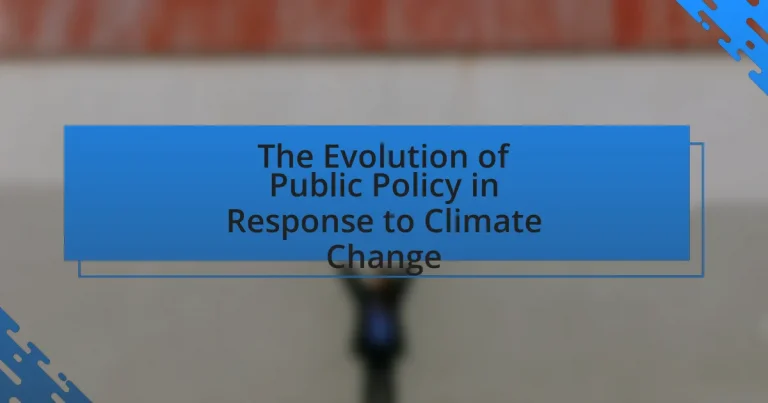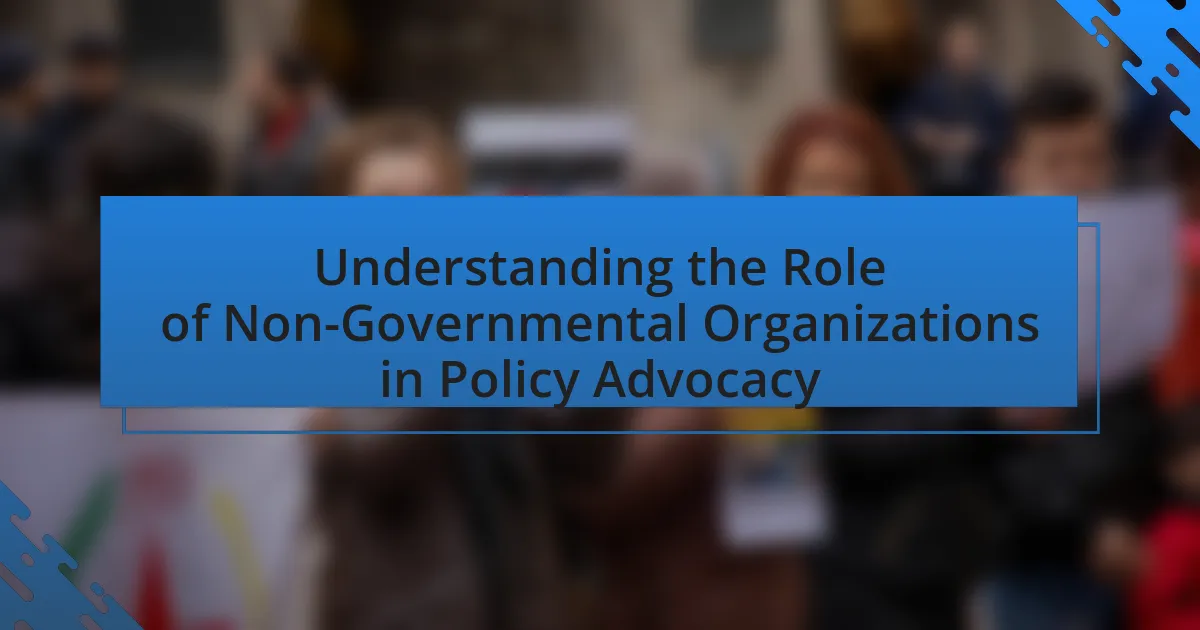The article examines the evolution of public policy in response to climate change, highlighting key milestones such as the establishment of the Intergovernmental Panel on Climate Change (IPCC), the United Nations Framework Convention on Climate Change (UNFCCC), the Kyoto Protocol, and the Paris Agreement. It discusses how these international agreements have influenced national policies, emphasizing objectives like greenhouse gas mitigation, climate adaptation, and sustainable development. The article also addresses the role of economic factors, public engagement, and technological innovations in shaping effective climate policies, while outlining current trends and future directions for policy development. Additionally, it explores the challenges policymakers face and the importance of collaboration among stakeholders in achieving successful climate action.
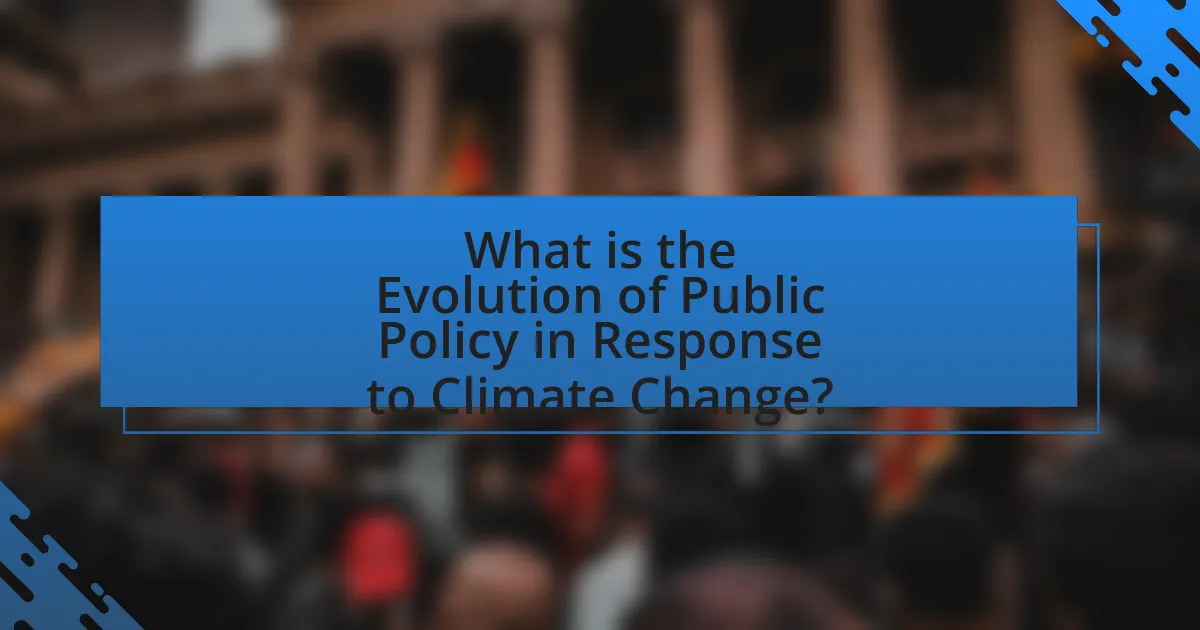
What is the Evolution of Public Policy in Response to Climate Change?
The evolution of public policy in response to climate change has progressed through several key phases, beginning with early awareness and culminating in comprehensive international agreements. Initially, in the late 20th century, policies focused on scientific research and awareness, exemplified by the establishment of the Intergovernmental Panel on Climate Change (IPCC) in 1988, which aimed to assess climate change impacts and inform policy.
As understanding deepened, the 1992 United Nations Framework Convention on Climate Change (UNFCCC) marked a significant step, establishing a framework for international cooperation. This was followed by the Kyoto Protocol in 1997, which set binding emission reduction targets for developed countries, reflecting a shift towards regulatory measures.
In the 21st century, public policy evolved further with the Paris Agreement in 2015, where countries committed to limit global warming to well below 2 degrees Celsius, emphasizing nationally determined contributions (NDCs). This agreement represented a transition from top-down mandates to more flexible, country-specific commitments.
Recent trends indicate a growing integration of climate considerations into broader policy areas, such as economic development and energy policy, with many nations adopting green recovery strategies post-COVID-19. This evolution reflects an increasing recognition of climate change as a multifaceted challenge requiring coordinated, cross-sectoral responses.
How has public policy historically addressed climate change?
Public policy has historically addressed climate change through a series of international agreements, national regulations, and local initiatives aimed at reducing greenhouse gas emissions and promoting sustainability. The 1992 United Nations Framework Convention on Climate Change (UNFCCC) marked a significant milestone, establishing a framework for global cooperation on climate issues. Subsequent agreements, such as the Kyoto Protocol in 1997, set binding emission reduction targets for developed countries, while the Paris Agreement in 2015 aimed to limit global warming to well below 2 degrees Celsius. Nationally, countries have implemented policies like carbon pricing, renewable energy incentives, and emissions trading systems to mitigate climate impacts. Local governments have also enacted zoning laws and sustainability programs to enhance resilience and reduce carbon footprints. These historical actions demonstrate a growing recognition of climate change as a critical issue requiring coordinated policy responses at multiple levels.
What key milestones have shaped public policy regarding climate change?
Key milestones that have shaped public policy regarding climate change include the establishment of the United Nations Framework Convention on Climate Change (UNFCCC) in 1992, which set the foundation for international climate negotiations. The Kyoto Protocol, adopted in 1997, was significant as it legally bound developed countries to emission reduction targets. The Paris Agreement, reached in 2015, marked a pivotal moment by uniting nearly all nations in a commitment to limit global warming to well below 2 degrees Celsius. Additionally, the Intergovernmental Panel on Climate Change (IPCC) reports have provided critical scientific assessments that inform policy decisions. These milestones collectively reflect the evolving global consensus on the urgency of addressing climate change through coordinated policy efforts.
How have international agreements influenced national policies?
International agreements have significantly influenced national policies by establishing frameworks and commitments that countries adopt to address climate change. For instance, the Paris Agreement, adopted in 2015, set binding targets for greenhouse gas emissions reductions, prompting nations to develop and implement policies that align with these international commitments. As a result, countries like Germany and the United Kingdom have enacted comprehensive climate action plans, including renewable energy initiatives and carbon pricing mechanisms, to meet their obligations under the agreement. This demonstrates how international agreements serve as catalysts for national policy reform, driving legislative and regulatory changes aimed at mitigating climate change impacts.
What are the main objectives of public policy in response to climate change?
The main objectives of public policy in response to climate change are to mitigate greenhouse gas emissions, adapt to climate impacts, and promote sustainable development. Mitigation efforts focus on reducing emissions through regulations, incentives for renewable energy, and energy efficiency standards. Adaptation strategies aim to enhance resilience against climate-related impacts, such as extreme weather events, by investing in infrastructure and community planning. Sustainable development initiatives seek to balance economic growth with environmental protection, ensuring that policies support long-term ecological health while addressing social equity. These objectives are supported by international agreements like the Paris Agreement, which sets targets for emission reductions and encourages global cooperation.
How do these objectives align with environmental sustainability?
The objectives align with environmental sustainability by promoting practices that reduce greenhouse gas emissions and enhance ecosystem resilience. These objectives often include transitioning to renewable energy sources, implementing energy efficiency measures, and protecting natural habitats, all of which contribute to lowering carbon footprints and preserving biodiversity. For instance, policies aimed at reducing fossil fuel dependency directly support sustainability goals by mitigating climate change impacts, as evidenced by the International Energy Agency’s report indicating that renewable energy could account for 80% of global electricity by 2050.
What role do economic factors play in shaping these objectives?
Economic factors significantly influence the objectives of public policy in response to climate change by determining the allocation of resources and prioritization of initiatives. For instance, the cost of renewable energy technologies has decreased dramatically, with solar energy costs dropping by 89% since 2009, prompting governments to adopt policies that promote clean energy investments. Additionally, economic incentives, such as carbon pricing and subsidies for green technologies, shape policy objectives by encouraging businesses and consumers to reduce emissions. The economic impact of climate change, estimated to cost the global economy up to $23 trillion by 2050 if unaddressed, further drives policymakers to integrate economic considerations into climate strategies, ensuring that objectives align with sustainable growth and resilience.
Why is public engagement important in the evolution of climate policy?
Public engagement is crucial in the evolution of climate policy because it fosters democratic participation and ensures that diverse perspectives are considered in decision-making. Engaging the public allows policymakers to understand community values, concerns, and priorities, which can lead to more effective and equitable climate solutions. For instance, studies show that inclusive public consultations can enhance policy legitimacy and public support, as seen in the 2015 Paris Agreement, where widespread public advocacy played a significant role in shaping international climate commitments.
How does public opinion impact policy decisions?
Public opinion significantly impacts policy decisions by influencing lawmakers and government officials to align policies with the views and preferences of their constituents. For instance, when a substantial portion of the public expresses concern about climate change, elected representatives often respond by advocating for environmental regulations or renewable energy initiatives. A notable example is the 2019 Global Climate Strike, which saw millions of people worldwide demand action on climate change, leading to increased political discourse and commitments to climate policies in various countries. This demonstrates that public sentiment can drive legislative agendas and prompt governments to prioritize specific issues based on the collective voice of the populace.
What strategies can enhance public participation in climate policy development?
Strategies that can enhance public participation in climate policy development include implementing inclusive stakeholder engagement processes, utilizing digital platforms for broader outreach, and fostering educational initiatives to raise awareness about climate issues. Inclusive stakeholder engagement ensures diverse voices are heard, which is critical for effective policy-making; for instance, the United Nations Framework Convention on Climate Change emphasizes the importance of involving various community groups in decision-making. Digital platforms, such as social media and online surveys, can facilitate real-time feedback and engagement, as evidenced by the success of online consultations in various countries that have led to more representative climate policies. Educational initiatives, such as workshops and community forums, empower citizens with knowledge, enabling them to contribute meaningfully to discussions, as shown by programs in countries like Sweden, where public education has significantly increased participation in climate policy dialogues.
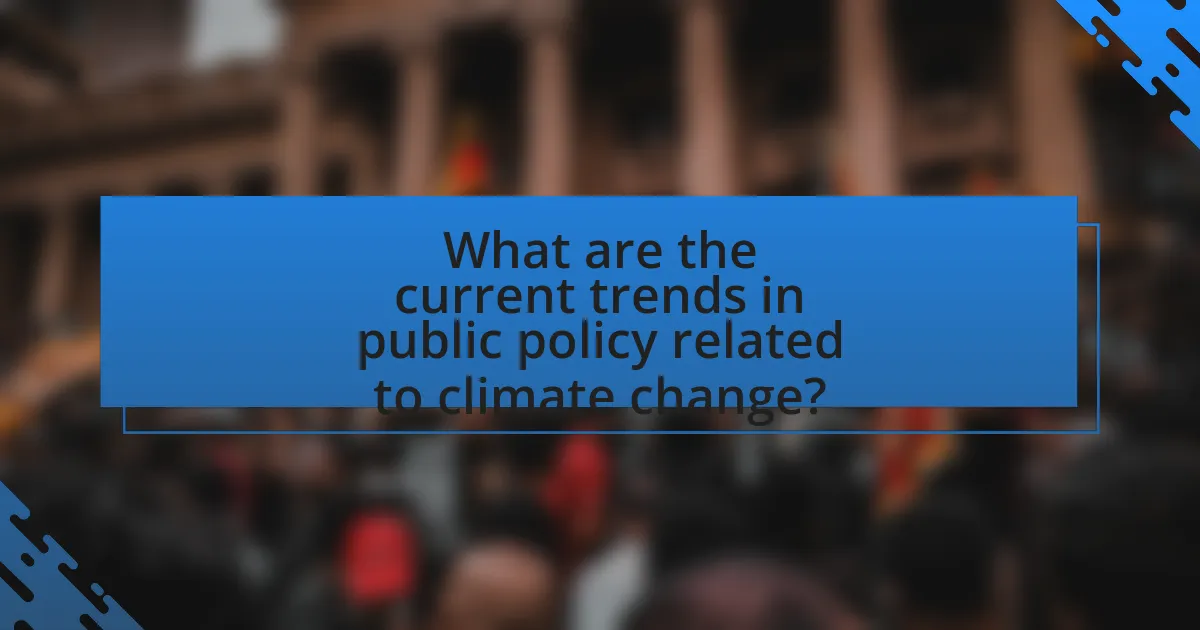
What are the current trends in public policy related to climate change?
Current trends in public policy related to climate change include a significant shift towards net-zero emissions targets, increased investment in renewable energy, and the implementation of carbon pricing mechanisms. Governments worldwide are committing to achieving net-zero emissions by mid-century, with countries like the United Kingdom and Canada enacting legislation to formalize these targets. Additionally, there is a growing emphasis on transitioning to renewable energy sources, as evidenced by the European Union’s Green Deal, which aims to allocate substantial funding for clean energy projects. Carbon pricing, through mechanisms such as cap-and-trade systems and carbon taxes, is being adopted by various jurisdictions to incentivize emissions reductions and promote sustainable practices. These trends reflect a comprehensive approach to addressing climate change through regulatory frameworks and financial incentives.
How are governments adapting policies to meet climate challenges?
Governments are adapting policies to meet climate challenges by implementing stricter regulations on emissions, promoting renewable energy sources, and enhancing climate resilience strategies. For instance, the European Union has set a legally binding target to reduce greenhouse gas emissions by at least 55% by 2030 compared to 1990 levels, demonstrating a commitment to aggressive climate action. Additionally, many countries are investing in infrastructure improvements to withstand climate impacts, such as rising sea levels and extreme weather events, as seen in the United States’ Infrastructure Investment and Jobs Act, which allocates funds for climate-resilient projects. These policy adaptations reflect a growing recognition of the urgent need to address climate change through comprehensive and actionable frameworks.
What innovative approaches are being implemented in climate policy?
Innovative approaches being implemented in climate policy include the integration of carbon pricing mechanisms, which incentivize emission reductions by assigning a cost to carbon emissions. Countries like Canada and Sweden have successfully adopted carbon taxes, leading to significant decreases in greenhouse gas emissions; for instance, Sweden’s carbon tax has contributed to a 25% reduction in emissions since its introduction in 1991. Additionally, the use of nature-based solutions, such as reforestation and wetland restoration, is gaining traction, as these methods not only sequester carbon but also enhance biodiversity and ecosystem resilience. The European Union’s Green Deal exemplifies this approach, aiming for climate neutrality by 2050 through investments in sustainable practices and technologies. These innovative strategies reflect a shift towards more comprehensive and effective climate policies that address both environmental and economic challenges.
How do local policies differ from national policies in addressing climate change?
Local policies typically focus on specific community needs and conditions, while national policies address broader, systemic issues related to climate change. Local governments often implement targeted initiatives such as urban planning, waste management, and local renewable energy projects that directly impact their communities. For example, cities like San Francisco have enacted strict building codes to enhance energy efficiency, reflecting local priorities. In contrast, national policies, such as the United States’ Clean Air Act, set overarching regulations and standards that apply across the entire country, aiming to reduce greenhouse gas emissions on a larger scale. National policies often provide funding and frameworks that local governments can adapt to their specific contexts, but they lack the granularity and immediacy of local initiatives.
What role do non-governmental organizations play in shaping climate policy?
Non-governmental organizations (NGOs) play a crucial role in shaping climate policy by advocating for environmental protection, influencing public opinion, and holding governments accountable. NGOs engage in research, provide expert analysis, and mobilize grassroots movements to raise awareness about climate issues, thereby impacting policy decisions. For instance, organizations like Greenpeace and the World Wildlife Fund have successfully lobbied for international agreements such as the Paris Agreement, which aims to limit global warming. Their efforts often include publishing reports that highlight the urgency of climate action, thus providing evidence-based recommendations that policymakers consider when drafting legislation.
How do NGOs influence public awareness and policy advocacy?
NGOs influence public awareness and policy advocacy by mobilizing communities, disseminating information, and engaging in lobbying efforts. They raise awareness through campaigns that educate the public about climate change impacts, often utilizing social media and grassroots organizing to reach diverse audiences. For instance, organizations like Greenpeace and the World Wildlife Fund have successfully used high-profile campaigns to highlight environmental issues, leading to increased public concern and pressure on policymakers. Additionally, NGOs often provide research and expert testimony to inform legislative processes, as seen in the work of the Climate Action Network, which has contributed to international climate agreements by advocating for science-based policies. Their ability to connect local experiences with global narratives enhances their effectiveness in shaping both public opinion and policy decisions.
What partnerships are forming between governments and NGOs?
Governments and NGOs are forming partnerships focused on climate change mitigation and adaptation strategies. These collaborations often involve joint initiatives aimed at reducing greenhouse gas emissions, enhancing community resilience, and promoting sustainable practices. For instance, the United Nations Framework Convention on Climate Change (UNFCCC) has facilitated partnerships between national governments and NGOs to implement climate action plans, such as the Climate Action Network, which mobilizes civil society to influence policy decisions. Additionally, various governments have engaged NGOs in projects like reforestation and renewable energy development, demonstrating a commitment to integrating diverse expertise and resources in addressing climate challenges.
What challenges do policymakers face in implementing climate policies?
Policymakers face significant challenges in implementing climate policies, primarily due to political resistance, economic constraints, and public perception. Political resistance often stems from differing ideologies and interests among stakeholders, which can hinder consensus on climate action. Economic constraints include the high costs associated with transitioning to renewable energy sources and the potential impact on jobs in traditional industries, making it difficult to gain widespread support for necessary changes. Additionally, public perception can complicate implementation, as misinformation and lack of awareness about climate issues may lead to skepticism regarding the effectiveness of proposed policies. These challenges are evidenced by the slow progress in international agreements, such as the Paris Agreement, where countries struggle to meet their commitments due to internal and external pressures.
How do political and economic barriers affect policy effectiveness?
Political and economic barriers significantly hinder policy effectiveness by creating obstacles to implementation and resource allocation. Political barriers, such as partisan divisions and lack of consensus, can lead to stalled legislation and inadequate support for climate initiatives, as seen in the United States where climate policy has often been a contentious issue, resulting in inconsistent regulatory frameworks. Economic barriers, including limited funding and competing financial interests, restrict the ability to invest in sustainable technologies and infrastructure, exemplified by the reluctance of fossil fuel-dependent economies to transition to renewable energy sources due to perceived economic risks. These barriers collectively undermine the capacity of policies aimed at addressing climate change to achieve their intended outcomes, as evidenced by the failure of many countries to meet their emissions reduction targets under international agreements like the Paris Accord.
What strategies can overcome these challenges?
Strategies to overcome challenges in public policy related to climate change include implementing adaptive governance frameworks, enhancing stakeholder engagement, and promoting evidence-based decision-making. Adaptive governance allows for flexibility in policy adjustments as new climate data emerges, ensuring that policies remain relevant and effective. Enhanced stakeholder engagement fosters collaboration among government, businesses, and communities, leading to more comprehensive and accepted solutions. Evidence-based decision-making utilizes scientific research and data analytics to inform policies, increasing their effectiveness and public trust. For instance, the Intergovernmental Panel on Climate Change (IPCC) emphasizes the importance of integrating scientific findings into policy frameworks to address climate-related challenges effectively.
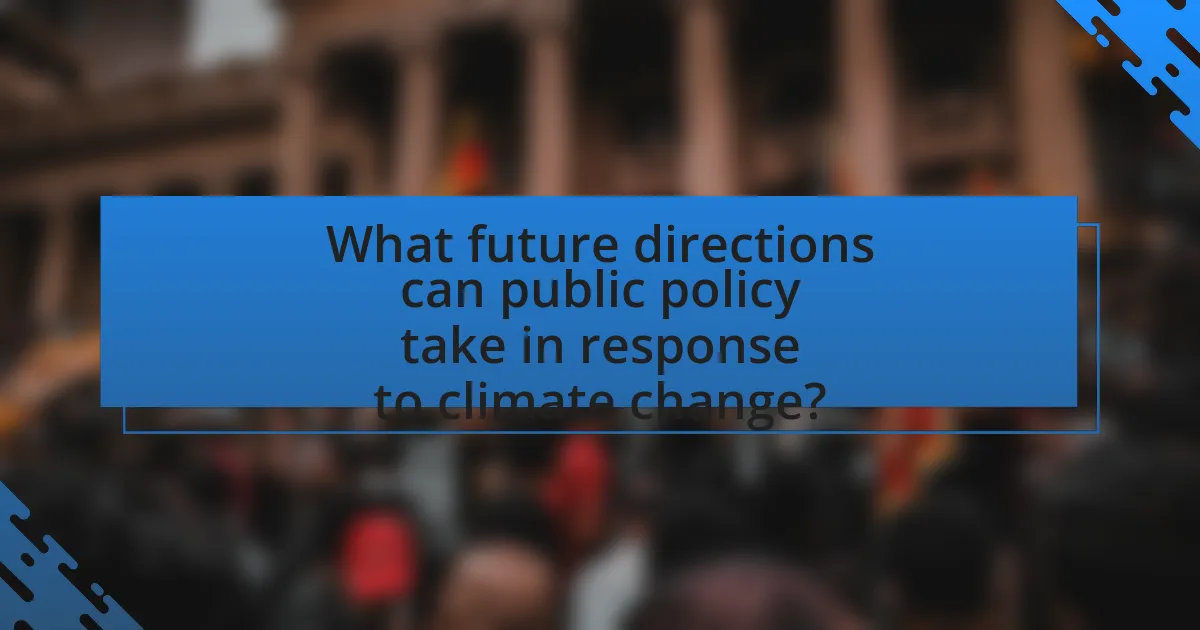
What future directions can public policy take in response to climate change?
Public policy can take future directions in response to climate change by implementing stricter emissions regulations, promoting renewable energy sources, and enhancing climate resilience strategies. Stricter emissions regulations can significantly reduce greenhouse gas emissions; for instance, the European Union’s Green Deal aims to cut emissions by at least 55% by 2030 compared to 1990 levels. Promoting renewable energy sources, such as wind and solar, can lead to a transition away from fossil fuels, as evidenced by the International Renewable Energy Agency reporting that renewable energy jobs reached 11.5 million globally in 2018. Enhancing climate resilience strategies, including infrastructure improvements and disaster preparedness, can mitigate the impacts of climate change, as highlighted by the National Oceanic and Atmospheric Administration’s findings that every dollar invested in disaster preparedness can save up to six dollars in recovery costs.
How can technology enhance public policy effectiveness in climate action?
Technology can enhance public policy effectiveness in climate action by providing data-driven insights and facilitating real-time monitoring of environmental changes. For instance, satellite imagery and remote sensing technologies enable governments to track deforestation, urban heat islands, and greenhouse gas emissions accurately. This data allows policymakers to make informed decisions, prioritize interventions, and allocate resources efficiently. Additionally, platforms for public engagement, such as mobile applications and social media, foster community involvement and transparency, which can lead to more robust policy support and compliance. Studies have shown that regions utilizing advanced technology for climate monitoring have improved their policy outcomes significantly, demonstrating the critical role of technology in shaping effective climate action strategies.
What technological innovations are currently influencing climate policy?
Technological innovations currently influencing climate policy include renewable energy technologies, carbon capture and storage (CCS), and advanced data analytics. Renewable energy technologies, such as solar and wind power, have significantly reduced costs and increased adoption, prompting governments to implement policies that support clean energy transitions. For instance, the International Renewable Energy Agency reported that the cost of solar photovoltaic systems has dropped by over 80% since 2010, leading to increased investments and policy incentives in many countries.
Carbon capture and storage technologies are also shaping climate policy by providing solutions to reduce greenhouse gas emissions from industrial sources. The Global CCS Institute notes that there are currently over 30 large-scale CCS facilities in operation or under development worldwide, influencing regulatory frameworks aimed at emission reductions.
Advanced data analytics, including artificial intelligence and machine learning, are enhancing climate modeling and enabling more effective policy decisions. The use of these technologies allows for better prediction of climate impacts and optimization of resource management, which is reflected in policies that prioritize data-driven approaches to climate resilience.
How can data analytics improve policy decision-making?
Data analytics can improve policy decision-making by providing evidence-based insights that enhance understanding of complex issues. By analyzing large datasets, policymakers can identify trends, assess the impact of previous policies, and forecast future scenarios related to climate change. For instance, a study by the National Oceanic and Atmospheric Administration (NOAA) demonstrated that data analytics helped predict the economic impacts of climate-related disasters, allowing for more informed resource allocation and risk management strategies. This data-driven approach leads to more effective and targeted policies that address specific climate challenges, ultimately resulting in better outcomes for communities and the environment.
What best practices can be adopted for effective climate policy development?
Effective climate policy development can be achieved by adopting best practices such as stakeholder engagement, evidence-based decision-making, and adaptive management. Stakeholder engagement ensures that diverse perspectives are included, which enhances the legitimacy and acceptance of policies. Evidence-based decision-making relies on scientific data and research to inform policy choices, leading to more effective outcomes. Adaptive management allows for policies to be adjusted in response to new information and changing conditions, ensuring long-term effectiveness. For instance, the Intergovernmental Panel on Climate Change emphasizes the importance of integrating local knowledge and scientific research in policy formulation to address climate challenges effectively.
How can lessons learned from past policies inform future strategies?
Lessons learned from past policies can inform future strategies by providing insights into what has been effective or ineffective in addressing climate change. For instance, the implementation of the Kyoto Protocol in 1997 highlighted the challenges of binding commitments, leading to the development of more flexible frameworks like the Paris Agreement in 2015. This evolution demonstrates the importance of adaptability in policy design, as evidenced by the varying success rates of emissions reduction targets across different countries. Analyzing these historical outcomes allows policymakers to refine approaches, ensuring that future strategies are grounded in empirical evidence and tailored to specific contexts, ultimately enhancing their effectiveness in combating climate change.
What role does collaboration among stakeholders play in successful policy outcomes?
Collaboration among stakeholders is crucial for achieving successful policy outcomes, particularly in the context of climate change. Effective collaboration fosters diverse perspectives, enhances resource sharing, and builds consensus, which are essential for developing comprehensive and actionable policies. For instance, the Paris Agreement exemplifies how collaboration among governments, businesses, and civil society can lead to a unified approach to climate action, resulting in commitments from nearly 200 countries to reduce greenhouse gas emissions. This collaborative framework not only facilitates the pooling of knowledge and expertise but also ensures that policies are more inclusive and reflective of the needs of various communities, thereby increasing their effectiveness and sustainability.
What practical steps can individuals take to support climate policy initiatives?
Individuals can support climate policy initiatives by actively engaging in advocacy, reducing their carbon footprint, and participating in community efforts. Advocacy can involve contacting elected officials to express support for climate-friendly legislation, attending town hall meetings, or joining local environmental organizations. Reducing carbon footprints can be achieved through lifestyle changes such as using public transportation, conserving energy at home, and adopting a plant-based diet, which studies show can significantly lower greenhouse gas emissions. Participation in community efforts includes volunteering for local clean-up projects or tree-planting events, which not only enhance local environments but also raise awareness about climate issues. These actions collectively contribute to a stronger public mandate for effective climate policies.
